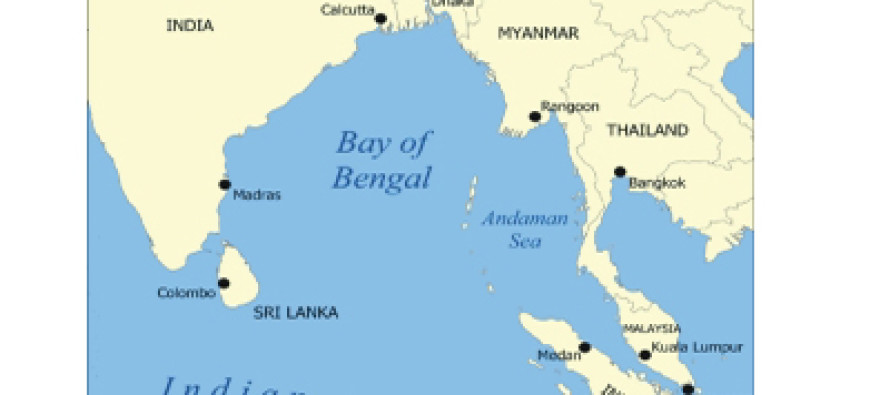Dhaka-Yangon Maritime Boundary Talks: A Big Step Forward

It is a good news that during the recent meeting (8th and 9th January) in Dhaka, the delegations from Bangladesh and Myanmar have been able to agree on the method of delimitation of sea boundary.
They reportedly agreed on the combination of both methods –equidistant and equity of resources– to draw the boundary. It is not only a big step forward to achieving a successful outcome but also demonstrates the determination of both countries to resolve the issue bilaterally.
The talks at earlier stages bogged down on the method how to proceed in demarcating the maritime boundary in the Bay of Bengal. While Bangladesh had proposed equity of resources as the method of boundary, Myanmar insisted on apply the equidistant method.
Bangladesh case was that if equidistant method was applied, a gross distortion would take place in the boundary line making it much narrower than Bangladesh deserved and was thus not acceptable.
Law under the UN Convention:
The 1982 Convention on the Law of the Sea provides guidelines for drawing maritime boundary as between states.
Bangladesh ratified the 1982 UN Convention on the Law of the Sea (UNCLOS) in July 2001 while Myanmar ratified it in May 1996. This means both states are legally bound by the provisions of the UNCLOS in delimiting the maritime boundary
There are three issues to be settled with Myanmar with regard to delimitation of maritime boundary: (a) Territorial Sea (b) Exclusive Economic Zone (c) Continental Shelf (sea bed).
The territorial sea extends to 12 nautical miles, the exclusive economic zone to another 188 miles and the continental shelf may extend another 150 miles. In all 350 miles of maritime boundary are involved.
The jurisdiction of a state on territorial sea is three dimensional—control on airspace of the territorial sea, surface water and seabed except “innocent passage” of foreign ships, while the jurisdiction on economic zone and continental shelf is resources-oriented. States has the exclusive right to explore, exploit, preserve, conserve and protect living and non-living resources of the sea of these areas.
With regard to the territorial sea, Article 15 of the UN Convention on the Law of the Sea (UNCLOS) provides the equidistant method for its delimitation, unless the states concerned agree otherwise.
The equidistant method is drawing a median line every point of which is equidistant from the nearest points on the baselines from which the breadth of the territorial sea is measured. It is a line based on geometric calculations.
With regard to the delimitation of economic zone and continental shelf, UNCLOS in its Articles 74 and 83 does not provide equidistant method as the basis of agreement.
Both the Articles provide that the delimitation agreement on economic zone and continental shelf must achieve “equitable solution” That means justice and fairness must guide the negotiations leading to an equitable solution.
I would argue Bangladesh’s concavity and heavily indented coastline, natural prolongation of its land territory to continental shelf, its scanty natural resources in proportion of the huge population, and the general orientation of the Bangladesh’s topography are some of the factors to be considered by Myanmar in determining the maritime boundary of Bangladesh to achieve an equitable solution, as contemplated by the UN Convention.
Another fact is to be borne in mind that the claim in the areas in the Bay of Bengal constitutes about 10-12% of Myanmar’s but Bangladesh’s stake is 100% per cent. Bangladesh should get a fair and just share of the continental shelf (sea bed) of the Bay of Bengal in terms of the UN Convention.
It is further claimed that equidistance method, if applied, will lose 48,025 square kilometres to Myanmar. Bangladesh’s total claimed maritime area, according to some researchers, is 2,07,000 square kilometres in the Bay of Bengal under the 1974 Bangladesh Territorial Waters and Maritime Zones Act.
Bilateral Negotiations:
The very fact that Bangladesh and Myanmar sat for negotiations on maritime boundary in April 2008 after a lapse of 22 years demonstrated the willingness of both countries to achieve an accord on this important issue when sources of energy are explored from maritime areas (sea bed)..
Negotiation implies persuasion and compromise without abandoning vital national interests. It is compared to a game where the ball is always on the move and all endeavours are made for the ball not to sit with one side. Negotiations involved understanding of the other’s point of view and in all successful negotiations it becomes necessary to give something in return to the other side.
The peoples of Bangladesh and Myanmar are neighbours and have stood the test of friendship and amity since time immemorial. Bangladesh Foreign Minister visited Myanmar in May 2009 and discussed many bilateral issues that would strengthen further the bonds of friendship between the two countries. Against the background, it is heartening that bilateral negotiations on sea boundary have turned into a positive momentum and the next meeting would be held in April.
Given the spirit of goodwill and mutual respect for each other, I would argue there is no adequate reason why the maritime boundary issue cannot be resolved to a mutually accepted solution as many neighbouring countries have done across the world.
It is noted that although Bangladesh has lodged the issue of the sea boundary to international arbitration under Chapter XV of UNCLOS, it does not exclude bilateral negotiations to a successful outcome and in fact the UNCLOS emphasises bilateral agreement as a preferable method to achieve the mutually satisfactory result.
It is hoped that India will adopt similar stance in resolving the maritime boundary issue with Bangladesh.
By Barrister Harun ur Rashid
Former Bangladesh Ambassador to the UN, Geneva.


